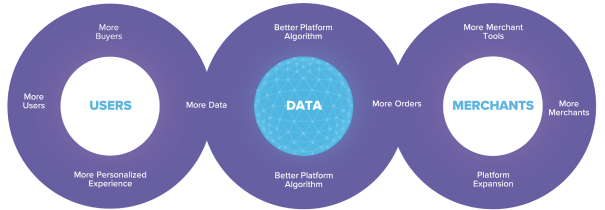Value-conscious consumers represent a large and growing portion of the global consumer population and have been historically underserved by traditional e-commerce. For this segment, price is often the most crucial determinant when purchasing.
This value-conscious population has the significant and highly resilient buying power, which the success of discount retailers can evidence. While traditional brick-and-mortar retail faces challenges, discount retailers remain resilient as bargain-hunting consumers continue to shop at value-focused stores.
Discovery is a foundational aspect of the brick-and-mortar shopping experience. Shopping in-store allows consumers to browse and discover new products that they want, driving many consumers to purchase items beyond their planned purchases. This type of navigational browsing often creates purchase intent for new products.
However, the largest e-commerce companies in the world were created on the desktop, and their consumer experiences are predominantly search-driven rather than discovery-based. When porting that search-driven experience to mobile, consumers can shop for what they know they need but need help browsing, engaging, and discovering new products.
On the merchants’ side, they lack the tools to operate their businesses efficiently, including expertise and resources to acquire users, shipping and logistics platform, payment capabilities, access to credit, adequate user support, and comprehensive data insights.
Wish was launched in 2010 to bring an affordable and entertaining mobile shopping experience to billions of consumers worldwide. Wish combines technology and data science capabilities, an innovative and discovery-based mobile shopping experience, a comprehensive suite of merchant services, and a massive scale of users, merchants, and items.
As strategy enthusiasts, we decided the analyze the business model of Wish and learn how does Wish work and make money. What is the marketing strategy of Wish? Who are the major competitors of Wish? Let’s find out.
What is Wish? How does Wish work?
Wish is an American online e-commerce platform for transactions between sellers and buyers. Wish was founded in 2010 by Piotr Szulczewski (former CEO) and Danny Zhang (former CTO). Wish wants to unlock e-commerce for consumers and merchants, by providing consumers access to a vast selection of affordable products and by offering merchants access to hundreds of millions of consumers globally.
Wish has become one of the largest and fastest-growing global e-commerce platforms, connecting more than 74 million monthly active users (as of 2021) in over 100 countries to over 250,000 merchants selling approximately 900,000 items per day. Wish was built to serve consumers who favor affordability over brand and convenience and are being underserved by traditional e-commerce platforms.
As was mentioned before, the business model of Wish aims to solve the problem of the discoverability of e-commerce platforms. Using data science capabilities, Wish mirrors how consumers have shopped for decades in brick-and-mortar stores by offering a discovery-based shopping experience on a mobile device. Over 70% of the sales on Wish do not involve a search query and, instead, come from personalized browsing.
Wish works to enhance user engagement by incorporating fresh gamified features, rich user-generated content, including photos, videos, and reviews, and a wide range of relevant products to make shopping more entertaining.
Wish also works to empower merchants worldwide. Most of Wish’s merchants are from China due to these merchants’ strength in selling quality products at competitive prices. Wish provides merchants immediate access to a global base of active users and a comprehensive suite of indispensable services, including demand generation and engagement, user-generated content creation, data intelligence, promotional and logistics capabilities, and business operations support, all in a cost-efficient manner.
With the growth in e-commerce, local brick-and-mortar stores worldwide are struggling to attract consumers and compete. Wish launched Wish Local in 2019 to help these merchants increase their online reach and discovery, gain foot traffic, and drive additional sales. These Wish Local partners also serve as Wish Pickup locations for online Wish orders, which effectively gives Wish a local warehousing and fulfillment footprint worldwide without owning any real estate.
The business model of Wish benefits from powerful network effects. As Wish grows, it accumulates more data across user and merchant activities to create an even better experience, attracting more users and merchants. As more users come to Wish, driven by the affordable value proposition and differentiated shopping experience, Wish drives more sales to its merchants.

Adding more users also reinforces the user-generated feedback loop of ratings, reviews, photos, and videos, which drives greater user engagement. As more merchants succeed on Wish, more merchants join the platform to grow their businesses, broadening the product selection and improving the user experience. This flywheel effect has driven tremendous value to both users and merchants and has made Wish one of the largest e-commerce marketplaces in the world.
How does Wish make money? What is the business model of Wish?
Value proposition
Users
- Affordable: To value-conscious consumers, merchants on Wish offer primarily unbranded products that can be deeply discounted compared to branded alternatives across several categories.
- Discovery-Based: Unlike other e-commerce platforms where consumers often visit with a predetermined purchase intent for specific items, Wish’s navigational and entertaining shopping experience creates purchase intent in users across a diverse set of products and categories.
- Personalized: Utilizing big data technology, Wish enables customization on a massive scale. Wish delivers personalized and curated products to users and helps them discover desired products quickly.
Merchants
- Accessible and Cost-Efficient E-commerce Platform: Wish gives merchants immediate access to its global base of active users and a comprehensive suite of merchant services in a cost-efficient manner to help them run their businesses and grow sales.
- Engagement: Wish merchants can amplify their reach and sales by utilizing its native advertising tool, ProductBoost. Wish uses data science to optimize ad placement, target users, and maximize the merchant’s return on ad spend.
- Data Intelligence: Wish provides merchants with a comprehensive data set to help them improve their performance in terms of total impressions, overall sales, product assortment, service quality, fulfillment, shipping needs, and refunds, among others.
- Logistics: Wish has developed several logistics programs to provide reliable cross-border logistics solutions at competitive costs for the merchants. Through Wish Local partnerships, Wish enables its online merchants to send their inventory to more than 60,000 partner pick-up locations near users to allow for quicker, localized pick-up.
Sales & Marketing Strategy of Wish
The sales and marketing strategy is an essential component to the success of the Wish business model. Wish focuses on acquiring and retaining new users and building brand awareness efficiently. Wish has built experiences in cost-effective, data-driven digital marketing and user acquisition.
Wish also designs innovative marketing programs that help increase brand awareness by targeting people who are more likely to engage with Wish’s platform and buy from its merchants.
Wish currently acquires new users through various marketing channels, including social media, search engine optimization, and brand-oriented marketing campaigns. Wish relies on its data to understand consumer behavior and the consumer’s long-term value, which guides its acquisition strategy.
Wish has developed technologies enabling it to build data-driven and highly personalized campaigns that scale globally on digital platforms, including Facebook, Instagram, and various Google properties.
The marketing strategy of Wish also focuses on retargeting existing users, building a brand, generating awareness, and cultivating the Wish community. Wish invests in efficient sales and marketing activities to identify and onboard high-potential merchants worldwide both for the online marketplace and Wish Local.
Like user acquisition strategies, Wish deploys digital performance marketing campaigns on social media and other channels to acquire new merchants. Wish supplements this effort with offline marketing activities, including attending trade shows and conducting seminars. Wish also leverages partnerships with third-party platforms for merchant referrals.
Wish Competitors
Wish competes for both users and merchants. For users, Wish competes on the basis of affordability and user experience. For merchants, Wish competes on the basis of providing profitable distribution, an end-to-end platform, and global reach.
Wish’s online competitors include large, global e-commerce platforms such as Amazon, Alibaba, Shein, and Shopify and more traditional discount retailers such as Walmart and Target. Wish’s offline competitors also include scaled discount retailers that offer heavily discounted and off-season products, such as Dollar General and TJ Maxx.
How does Shopify make money | Business Model
Wish competes for users based on its massive product selection, low prices and daily discounts, deeply personalized and differentiated shopping experience, and entertainment derived from various engaging and interactive features of its platform.
“All-Inclusive” business model of Amazon Prime
How does Wish make money: revenue model
Wish made $2.1 billion in 2021. Wish makes money from the marketplace and logistics services provided to customers (merchants). In Marketplace revenue, Wish makes money from commission fees collected with user purchases of the merchants’ products. In logistics services, Wish makes money from Merchants for delivery services.
Revenue decreased $456 million, or 18%, to $2.1 billion for 2021 compared to $2.5 billion for 2020. This decrease was attributable to reduced marketplace revenue partially offset by increased logistics revenue.
Marketplace revenue
Marketplace contributed 63% to Wish’s revenue in 2021. Wish provides a mix of marketplace services to its customers. Wish provides merchants access to its marketplace, where merchants display and sell their products to users. Wish also provides ProductBoost services to help merchants promote their products within its marketplace.
Marketplace revenue includes commission fees collected with user purchases of the merchants’ products. The commission fees vary depending on user location, demand, product type, and dynamic pricing. Marketplace revenue also includes ProductBoost fees for displaying a merchant’s selected products in preferential locations.
Logistics revenue
Wish’s logistics offering for merchants, introduced in 2018, is designed for direct end-to-end order shipments from a merchant’s location to the user. Logistics services include transportation and delivery of the merchant’s products to the user. Merchants are required to prepay for logistics services on a per-order basis. Logistics contributed 37% to Wish’s revenue in 2021.
| (in $ Million) | 2018 | 2019 | 2020 | 2021 |
| Core marketplace revenue | 1508 | 1473 | 1827 | 1177 |
| ProductBoost revenue | 214 | 291 | 200 | 165 |
| Marketplace revenue | 1722 | 1764 | 2027 | 1342 |
| Logistics revenue | 6 | 137 | 514 | 743 |
| Total revenue | 1728 | 1901 | 2541 | 2085 |
















